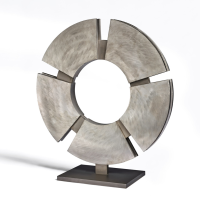
Modernism is in many ways understood as the concurrent elements of aesthetics and technology. In art, and sculpture particularly, what is most common is the technique required to design and fabricate forms. Whether a product is more functional or indeed abstract does not discount their shared, material underpinning. Avant-garde creatives of the early twentieth century explored the utopic appeal of technology through art, typography, design, and architecture; engineering new objects, spaces and experiences that seemed completely futural in concept and design. Inge Kings early career emerges in proximity to this historical moment while studying at the Berlin Academy of Arts and then the London Royal Academy in the late 1930s and 40s. Like many European migrs to Australia, King imported these avant-garde innovations, counting herself as a vital member of the influential Centre 5 group based in Melbourne. From the mid-1950s onwards, this alliance of sculptors included Clifford Last (1918-1991), Teisutis Zikaras (1922-1991), and Norma Redpath (1928-2013), who as a group advocated for the greater integration of modernist public sculpture into Australian life.Stellar Wheel 2010 belongs to a later body of work that acknowledges Kings interest in combining the celestial with technological and spiritual utopianism. This series emerged in the new millennium, a significant moment that marked a time of renewal and contemplation for many including King, now practising late in her career. Constructed at various scales, these works were usually made in stainless steel and consisted of circular motifs assembled in ways that evoked the grand orbital forces of stars and planets. Examples such as Planet 2009 and Celestial Rings I 2014 almost look like navigational instruments from the future, speculatively fusing the spiritual and terrestrial, their exact function unknown yet dormant in their machinic design. Rather than being patinated like much of her preceding work which usually dulls and absorbs light they are rendered with a reflective chromium surface that distils a total newness.Stellar Wheel is a minimal assembly of uniform segments fixed to a ring armature. They radiate harmoniously from a central, circular void. Here, King utilises negative space between the segments to animate the piece, creating a sense of delicate momentum. Although it lacks ornamentation, immense detail is discovered on the brushed surface. King uses an angle grinder on the stainless-steel, creating detailed striations from which gleams of light reflect. The transcendental referent for Stellar Wheel imbues it with an otherworldly presence, as if it is some lost component of a great, undiscovered astronomical clock. Tim MarvinTim Marvin is an emerging curator and art historian based in Sydney. He has a Bachelor of Art Theory (Honours, First Class) from the University of New South Wales, and currently holds positions at Sullivan + Strumpf and Artspace, Sydney.
